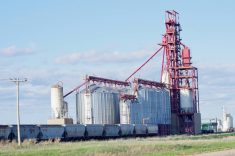Errol Anderson’s opinion on the global economic downturn isn’t one you’ll read in too many newspapers.

“I’m going to make a bold statement: We are at the end of an 80-year capitalistic cycle that has already been prolonged 10 years by central bank manipulation. It has to be refreshed, and it will be,” said Anderson, president of ProMarket Communications.
“I believe that economics always rule. Central bankers can do whatever they’re doing to kick the can (down the road) but in the end, economics always rule.
“There’s no sense in denying what’s going on in these financial markets right now.”
Central banks have been trying to jumpstart the flagging economy by printing money and adjusting interest rates, Anderson said at the Farming Smarter conference in early this month.
Read Also

Farming Smarter receives financial boost from Alberta government for potato research
Farming Smarter near Lethbridge got a boost to its research equipment, thanks to the Alberta government’s increase in funding for research associations.
“Right now, the central bank stimulus bubble is three times larger than the dot-com and the U.S. housing bubble combined,” he said. “We’ve got a very sleepy market right now. In 2017, we’re going to see it start to swing because economics are going to start to cut into these markets…. Something has to give.”
Government debt, along with consumer overspending, are the main drivers of the bubble, he said.
“In Canada, the election promise was a $10 billion deficit. Guess what it’s going to be? $34 billion. In Alberta, the original estimate was a $6 billion deficit. The latest estimate is $12 billion, but it’s going to go higher.
“That’s the economics of what’s affecting all of us — even people living in Medicine Hat.”
The ag fallout
So what does this mean for agricultural commodities?
“Demand is king — not supply,” said Anderson, pointing to the plunge in cattle prices.
“Cattle are in short supply, aren’t they? Shouldn’t prices hold? The cattle market was in tight supply, and we were told that these prices would continue to go higher into 2016 and 2017, and all of a sudden feeders went to half price. Why? Demand.”
People tend to think that supply and demand equals price, but “in reality, it doesn’t work that way.”
“It’s the guy with the chequebook and what he wants to pay that dictates that,” said Anderson. “So when you see strong demand — even on the grain side — all of a sudden it will quit and come back down. We go from buy, buy, buy to stop, stop stop.”
But until that happens, look to take advantage of little jumps in ag commodity prices, he said.
Crop outlook
For wheat, the story is “very aggressive” discounting by Russia and Ukraine, he said.
“The Black Sea region is really dictating where global wheat prices are going. Russia’s currency crumbled about a year ago, and that gave them a huge competitive advantage.”
“It’s going to be tough” if you’ve only got lower-quality wheat to sell. But there may be opportunities for No. 1 and No. 2 CWRS, which is in lower supply and being sought for blending.
“If you’ve got the good stuff, you could see $7 a bushel. It’s possible. The top bid I’ve heard is $6.85.”
Yellow pea prices have been all over the map, said Anderson.
“Yellow peas were $14 a bushel, and at harvest, they went about as low as $6.50, and now they’ve bounced up to about $7.50 — maybe a little higher for deferred, at $7.75,” he said.
“What’s the difference? India. Last year, India was buying like crazy. This year, they’re still buying, but they’re not buying as aggressively.”
Green peas are a little more stable, he added.
“Greens started at $8 a bushel and they’re probably at $8.50 now. It’s possible the greens might go to $9,” he said. “There’s a fairly good market, but the supply is great enough and the demand has pulled back enough that I don’t see $10 in these markets right now. The top end would be $8 a bushel for yellows and $9 a bushel on the greens.”
Canola continues to be supported by a weak Canadian dollar and the rising price of soy oil and soybeans.
“March canola has moved up to that $540 a tonne area at the top,” said Anderson. “Because soybeans are toppy, I’m sensing canola is toppy. But if we drop, it’s not going to be by much.”
Canola could drop by $15 or $20 a tonne, but “it will go back up,” he predicted.
“There’s just too much damage from harvest, and the margins are still really good on the crushing side.”
Barley, currently about $168 a tonne ($3.64 a bushel) in the Lethbridge area, is “range bound” and might hit $180 a tonne, in spring.
“It made a nice move up in October, and then in November, it started to peel back down a bit. Lethbridge was as high as about $175 a tonne a few weeks ago, and it’s weakened off a little bit.”
Part of the problem is, once again, demand in a limited export market.
“The only market that really might come in is Saudi Arabia,” he said. “They used to buy a couple million tonnes from us. If they were to step back in, suddenly we’ve got a different barley market, but I don’t see it at the moment.”
The barley feed market is also facing competition from wheat infected with vomitoxin, he added.
“The vomi-wheat that’s coming in from Saskatchewan is going into cattle rations, and it’s going to be a competitor. I believe that some of it is being landed in southern Alberta at $155 a tonne.”
Cattle outlook
“Grief” is a good word to describe the cattle market right now, said Anderson.
“What’s bugging cattle? Hogs. The hog market just fell apart,” he said. “The meat protein market in the U.S. went into a glut, and beef had to compete against that.”
Right now, the situation for feeder cattle is “ugly,” he said.
“Backgrounders took the brunt of this. It went from $240 a hundredweight down to $120. This feeding cycle was worse than BSE,” said Anderson.
But prices are now low enough that buying new calves has become possible, he added, and the backgrounding industry will start to make money on calves as long as “we don’t get over-exuberant.”
“$3 calves have turned down to $2 calves, and it’s sure nice to buy them below $2, but if the calves go to $2.25, it’s going to be another loss,” he said. “The reason I’m not so gung-ho about meat is because the U.S. is still waffling in pork and poultry. That’s not going to change for a while — maybe next spring.”
But on the other hand, fed cattle prices are “moving up, up, up, up.”
“We’ve seen Texas move up to $115 recently. They were at $98 as a low about six weeks ago. Alberta went from $128 up to $152 a pound. We’ve made about a 25 cent recovery on the Canadian fat cattle market,” said Anderson.
“Some of the fat cattle last week turned a profit, and we haven’t heard that in a while. It’s starting to bottom out, and we’re going to see the market start to gradually move up.”
But the boom years appear to be over, and producers — like those in the oil and gas sector — are going to have to adjust to the “new normal,” said Anderson.
“The new normal is prolonged, slow economic growth globally. Nothing is going to change that.”















